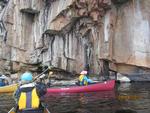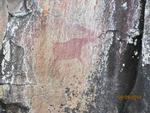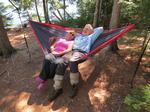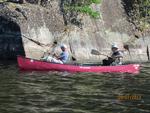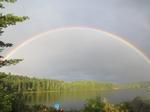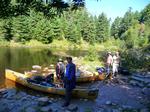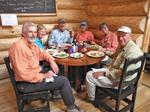BWCA Entry Point, Route, and Trip Report Blog
April 27 2024
Entry Point 16 - Moose/Portage River (North of Echo Trail)
Number of Permits per Day: 5
Elevation: 1348 feet
Latitude: 48.1230
Longitude: -92.0991
A favorite route offering many trip options and memorable things to see including;
World Class fishing for all four BWCA Species
Pictographs
Soaring granite hills and cliffs
Small lakes
Small rivers
Tumbling rapids and waterfalls
Wildlife, including Moose
Vistas from high points across the region if you're willing to climb. Rating Easy to Moderate. Day One. Get to EP16 off of the Echo Trail early. The initial portage is long, but well worn and smooth, sloping gently downgrade to the launch area. Load your canoe and head North. You'll be paddling with the slight current on this narrow winding river. The water is clear and make sure to tell the bowperson to watch for looming rocks!
Try to Remember a Day in September
Entry Date:
September 03, 2013
Entry Point:
Moose/Portage River (north)
Number of Days:
10
Group Size:
6
The longest day. September 3: We planned to spend our first night on Oyster Lake, and we knew the first day would be arduous. We entered the wilderness and traveled to Oyster Lake, 10 miles, nine portages. The weather was warm and sunny. We parked at EP16, unloaded, portaged through the forest 152 rods (half mile) to Moose River, and then paddled north to Nina Moose Lake. We inexplicably missed a short portage and blundered into a boulder jumbled rapid. Roy hopped into the waist deep river, filling his boots with water that sloshed all day. Moose River has three mapped portages, but fallen trees created two additional portages. The short portages on Moose River are 20-25r. We paddled north across Nina Moose Lake, and rested at the same sandy beach as last year. We continued to Lake Agnes 3 miles north down Nina Moose River, portaging 75r and 105r. High water made it easy to shoot through gaps in beaver dams when paddling downstream. Hummingbirds buzzed us twice, inspecting our red colored items. Both hummingbirds had juvenile or female plumage. Perhaps they will visit our feeders in Arkansas during migration. We arrived at Lake Agnes ahead of schedule at 1:30, and all six voyageurs seemed in good shape. Only two portages and short paddles remained before Oyster Lake. We paddled 1 km across Lake Agnes to portage 190r to Oyster River, reportedly a good trail, but actually an ordeal due to fallen trees, deer flies, fatigue, and boot-sucking muck at the river bank. Some of us triple-portaged this 190r trail, 3 cumulative miles on foot on this 0.6 mile portage trail. The mud sucked the sole right off the sole of Gay’s boot, and Al later astonished the group by producing shoe repair goop at camp. Gay should invest in boots that cost more than $19.95. While we portaged, the wind carried Al & Gay’s canoe down the Lake Agnes bank several hundred yards, a near faux pas. Fortunately, the canoe beached down shore, and not out in the middle of Lake Agnes, inasmuch as the other canoes awaited at the opposite end of the portage trail. We staggered to the mud hole on weedy Oyster River, and paddled wearily upstream to the final 70r portage to Oyster Lake. The nine portages will be remembered. Gay fell on her face in mud, Lee strode by and advised resting until he returned, as Gay’s mud puddle was near the end. Terri slipped on a rock, and rested there until extended a hand, and Vickie also performed the turtle impersonation on a portage. On reaching Oyster Lake, we found the shore steeply lined with boulders and the west wind blowing briskly, but we were too tired to be delayed by wind, so we launched from the boulders and paddled across to the peninsula to find our 5- star camp. We were relieved to find the camp unoccupied, and wearily pitched tents at 6 PM, our latest-ever arrival. Our campsite was the best on Oyster Lake, situated in the narrow middle of a long peninsula, affording canoe launches from either east or west. The fire pit area sits atop on a granite rise, affording fine views of the lake to the west and the heavens at night. (The BWCA website does not provide a camp number for this 5-star camp). We boiled water for a late dinner, gazed at starry constellations from our granite landing, and celebrated our accomplishment by drinking one of Al & Gay’s 5 liter boxes of wine. The first of many flocks of Canada geese appeared, flying V- shaped formations toward the east. Seems geese should fly south rather than east. 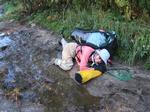
The world is your oyster. September 4 we rested at Oyster Lake. A family of gray jays visited camp. The weather was beautiful and calm, and everyone fished, and caught bass and pike for a fine fish dinner. In the afternoon Gay and Terri laundered clothes, while Lee and Al paddled the west side fishing. Oyster Lake is quiet and scenic, with a narrow peninsula jutting almost all the way across the lake. The peninsula has a fine granite bluff visible from the east, but you can't see the granite outcropping from our camp nestled among tall evergreen trees. An indignant family of beavers slapped tails at the intruding anglers. Vickie and Roy fished shady banks and caught ten smallmouth bass, then tried unsuccessfully to troll for lake trout in the deep waters. 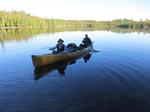
String of pearls. September 5 we traveled four hours to Gebeonequet Lake, 4 miles with 3 portages. We passed through two small, pretty lakes with three portages. The portages were medium length: 78r to Rocky Lake, 90r to Green Lake, and 130r to Gebeonequet Lake. Rocky and Green lakes are jewels, and aptly named. It was sunny with mild breezes. We failed to notice that maps indicate pictographs on Rocky Lake. We paddled across Gebeonequet and were delighted the 5-star camp on the north bank was unoccupied. Roy caught a nice smallmouth bass by twitching a topwater plug in front of camp before dinner.
From the land of sky blue waters … September 6 we base camped at Gebeonequet Lake. The weather was sunny and hot. Our campsite (118) was the best in Gebeonequet, with a granite landing, plenty of tent sites, expansive 180° view to the east. The wide, sloped granite porch was good for swimming and sunning. Gebeonequet is complex, with four inviting bays and several islands, too much to explore in one day. Gay’s almond milk leaked inside her pack, so she laid out foodstuffs on the grass like a garage sale. Vickie and Roy paddled to the south end and caught 36 smallmouth bass. Vickie twitched topwater lures and landed seven bass while Roy fished soft plastics Texas-rigged. Al and Gay caught several bass with fly rods, but decided that spinning or casting rods are better suited for the Boundary Waters. Lee and Terri caught 40-plus smallmouth with Terri out-fishing Lee with her hot SR-7 Rapala, and brought a stringer of bass for dinner. A large snapping turtle tried to steal the stringer of fish and engaged in a tug of war with Lee. The afternoon was hot and sultry, and Al led the way into the swimming hole in front of camp. The water was cool, and Al’s hooting and hollering echoed across the lake surface like a Roman orgy. The evening was humid, and mosquitoes chased us into our tents.
Citadel on a hill. September 7 we traveled to Lady Boot Bay, 6 miles, 2 portages. The weather was sunny and still. We paddled a few hundred yards to the short portage to Gebeonequet Creek. We glided easily downstream through golden marshes, and found the notorious beaver dam simple to cross in high water. We reached the confluence of Pocket Creek and floated over to the big lake. Lac la Croix was calm and we paddled south past massive islands with prominent granite bluffs to Lady Boot Bay. Vickie and Roy trolled unsuccessfully for Lake Trout over a deep hole en route. We soon reached the mouth of Lady Boot Bay, passed by an unoccupied campsite on the peninsula to claim a secluded hillside campsite in the back of the bay. The campsite was elevated, so we enjoyed an inspirational view from high above the bay. Roy belatedly realized we selected the wrong campsite (178). Roy planned for us to stay at the 5-star camp on the peninsula (179) at the mouth of the bay. Instead, we settled into the steep hillside aerie, and shuffled about like mountain goats. Whenever we dropped anything, it bounded down the mountain and nearly careened into the lake. In late afternoon, we explored the bay and coves. Lady Boot Bay is lovely and isolated, off the beaten path in busy Lac la Croix. Vickie and Roy watched a bull moose near Toe Lake, and the moose never took his eyes off us for five minutes before sauntering into a birch grove. Roy caught a fine 3 pound smallmouth bass by a fallen tree, and Lee landed a huge smallmouth by bouncing his lure off a sheer bluff into the lake. We wore sunglasses at dinner due to the setting sun’s glare across the bay.
Islands in the stream. September 8 we traveled 1¼ hour to an island camp in Fish Stake Narrows in eastern Lac la Croix, 4 miles and no portages. The day was bright and sunny, our sixth day of perfect weather. Originally, we planned to base camp 2-3 days at Lady Boot Bay, but decided to move sooner because some tent sites were sloped or subject to flooding, and the weather radio predicted rain. The 5-star island camp (236) in Fish Stake Narrows was first- rate. Four minks welcomed Terri & Lee to Fish Stakes Narrows. We all trolled around two islands facing the open lake and Canadian shore, and caught a few, but Al later found a school of fine walleyes in front of camp by a small, one- acre island a stone’s throw from camp, and provided a big walleye meal. Terri & Lee contributed bass and pike with Terri again out fishing Lee with her Rapala. Roy and Lee cleaned fish on a rocky point across from the campsite, annoying some resident beavers. The canoe drifted away while the two cleaned fish. Perhaps an irritable beaver pulled the canoe away from shore? Roy advocates swimming clothed to wash away portage mud (patent pending), and swam after the errant canoe. The predicted storm in the night never occurred. A barred owl hooted, the only owl heard during the trip.
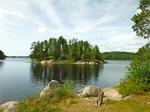
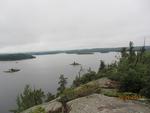
Somewhere over the rainbow. September 10 we traveled to Boulder Bay, 4 miles with no portages. The sky was partly cloudy. We paddled into Lac La Croix, hugging the west shore to avoid the windy open lake, passed through many islands, to a 5-star camp (306) in Boulder Bay. After setting up camp, Vickie and Roy paddled up the scenic Boulder River and fished a rapids, where Roy caught and released an 18” smallmouth and huge pike exceeding 30”. A brief downpour occurred while Vickie and Roy paddled down river to camp, ending with a splendid rainbow arching over the Boulder River. Back at camp, we all gazed in wonder at the most brilliant rainbow we ever saw, spanning the river. The sky cleared to display a pastel sunset. We hung clothes to dry, but midnight rain soaked them. We consumed the last of our eight boxes of wine.
Haven on a busy route. September 11 we traveled to Nina Moose Lake, 8 miles with 3 portages. The dawn was gorgeous. We paddled up Boulder River, and then portaged 118r to Lake Agnes. Lake Agnes was windy, and we paddled into steady headwinds to the river mouth, and then up Nina Moose River with 105 and 75r portages. We encountered the same beaver dam that challenged us last year when the water was lower, but we surged through gaps in the 12” rise by vigorous paddling and continued upstream. Nina Moose Lake is always busy due to proximity to the entry point and travel lanes, and our two preferred campsites were already occupied. Our third choice on the south bank between Moose and Portage rivers was a good campsite (1783) with room for four or more tents. We arrived at camp at 1:30 and ate a late lunch. A cold front approached from the west bringing a brief storm before clearing. We waited out the storm under our tarp, and then watched a pale golden sunset. Nina Moose Lake is weedy, and we were too busy drying wet clothes and tents and organizing gear to fish.
Déjà vu River. September 12 we returned to civilization. Our Nina Moose Lake campsite was only 3 miles and five portages from EP16 parking lot, and our last morning should have been easiest. Lee and Roy both packed away their maps because the route is simple and familiar. We paddled the short stretch along the weedy south bank, and then up the Moose River. We were surprised to encounter a half dozen beaver dams, although we paddled through gaps without difficulty. We did not remember beaver dams when we descended the river last week. Was the water that much lower? Is this the same river we descended nine days earlier? No travelers appeared to confirm our whereabouts. Vickie and Roy paddled ahead, and were relieved to recognize a familiar landmark, a steep granite promontory on the east bank a mile from the lake. Lee decided we were on the wrong river, so we turned around and returned to Nina Moose Lake to start over. Back in the lake again, we were confused, until Lee unpacked his GPS and realized we correctly ascended the Moose River the first time and should not have turned around and returned to the lake. The eye in the sky does not lie. We started back up the Moose River a second time. This time, we met numerous travelers entering the wilderness, but we were too proud to ask them if we were on Moose River, and we were no longer in doubt. By now, we were seasoned voyageurs, and we quickly overcame the four short portages, and then the final 152r trail back to the parking lot. We were already thinking about next year when we emerged from the forest trail at the parking lot. Soon, we were back at the Chocolate Moose restaurant quaffing cold beers.
Memories. We paddled 38 miles, not including day trips and one wrong turn, and we portaged 22 times on our loop route. Mosquitoes were bad, due to the warm temperature. We enjoyed seven beautiful sunny days, one rainy day, and two partly cloudy days with occasional showers. We hauled ten boxes of wine, totaling 28 liters, the equivalent of 37 bottles of wine. We enjoyed success fishing, as the winds were more moderate than last year. We were delighted by Oyster Lake, Gebeonequet Lake, and Lady Boot Bay and Fish Stake Narrows in Lac la Croix. The view from Warrior Hill will never be forgotten. Oyster and Gebeonequet Lakes are perfect, isolated get-away base camping lakes. We wish we could spend more than one night in secluded Lady Boot Bay. Fish Stake Narrows was wonderful, with excellent walleye fishing, although probably crowded during summer. 